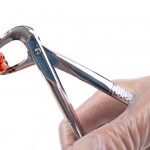
The use of warm salt water mouthrinses as part of a post extraction regimen is a commonly taught, yet as the authors of this trial found there seems to be little objective evidence for its effectiveness. The aim of this study was to determine the beneficial effect of different warm saline rinse regimens on the development of alveolar osteitis, acute inflamed socket, and acute infected socket following routine dental extraction.
Patients requiring a non-surgical dental extraction were randomised to one of three groups. Patients in group A (n=40) were instructed to gargle with warm saline six times daily and group B (n=40) to gargle twice daily; group C (n=40) were not instructed to use warm saline rinse and served as controls. Patients were evaluated 72h post-operatively for the presence of alveolar osteitis, acute inflamed socket, and acute infected socket, by an independent observer who was blinded to the treatment group.
- 120 patients were randomised, 40 in of the 3 groups each group.
- The overall prevalence of alveolar osteitis was 10.0% and that of acute inflamed socket was 25.0%.
- There were no significant differences between patients who gargled six times daily with warm saline and those who gargled twice daily with reference to either alveolar osteitis or acute inflamed socket (P>0.05).
- 2 patients in the saline group and 10 in the control group were diagnosed with alveolar osteitis
- Saline mouth rinses at either frequency were beneficial in the prevention of alveolar osteitis in comparison with those who did not rinse.
The authors concluded
The instruction to use warm saline mouth rinse is beneficial in the prevention of alveolar osteitis after dental extractions. There is no significant difference in the efficacy of the twice-daily warm saline mouth rinse regimen compared to the six times daily regimen. The twice-daily saline mouth rinse regimen is more convenient, and patient compliance may be better than with the six times daily rinse routine.
Comment
This is a small but interesting study of a commonly advised procedure that does not seem to have been formally investigated in clinical trials previously. The two saline arms have been combined and from the data presented it is possible to calculate the number needed to treat (NNT) with saline mouthwash to prevent one case of alveolar osteitis which is 4 (95% CI, 3-12). A Cochrane review by Daly et al in 2012 looked at local interventions to treat alveolar osteitis they found that:-
there is some evidence that rinsing with chlorhexidine (0.12% and 0.2%) or placing chlorhexidine gel (0.2%) in the sockets of extracted teeth, provides a benefit in preventing dry socket. There was insufficient evidence to determine the effects of the other 10 preventative interventions each evaluated in single studies.
Links
Osunde OD, Adebola RA, Adeoye JB, Bassey GO. Comparative study of the effect of warm saline mouth rinse on complications after dental extractions. Int J Oral Maxillofac Surg. 2013 Dec 4. pii: S0901-5027(13)01164-8. doi: 10.1016/j.ijom.2013.09.016. [Epub ahead of print] PubMed PMID: 24314857.
Daly B, Sharif MO, Newton T, Jones K, Worthington HV. Local interventions for the management of alveolar osteitis (dry socket). Cochrane Database of Systematic Reviews 2012, Issue 12. Art. No.: CD006968. DOI: 10.1002/14651858.CD006968.pub2.

RT @TheDentalElf: Trial suggests that post extraction use of warm saline mouth rinse reduces complications http://t.co/bLp3lwJvVs
La clásica salmuera de la que tanto renegaban, al menos mis docentes, cuando estudié odontología..y de la que yo – como buen campechano y pueblerino – habitualmente escuchaba a mis vecinos y vecinas :-)